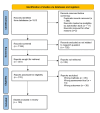Prevalence and Mitigation of Cardiovascular Disease Risk Factors Among the Corporate Workforce in Sub-Saharan Africa: A Systematic Review and Meta-Analysis
- PMID: 39822425
- PMCID: PMC11737606
- DOI: 10.7759/cureus.75888
Prevalence and Mitigation of Cardiovascular Disease Risk Factors Among the Corporate Workforce in Sub-Saharan Africa: A Systematic Review and Meta-Analysis
Abstract
Cardiovascular disease (CVDs) is the leading cause of mortality worldwide. Corporate workplaces have been identified as important environmental factors that can increase the risk and severity of CVDs. Evidence indicates that the risk and severity of CVDs can be effectively reduced by mitigating modifiable behavioural and intermediate risk factors. Although the prevalence of CVDs and their associated risk factors is increasing in sub-Saharan Africa (SSA), most published data from the region are hospital-based and may not be true estimates. This study investigated the prevalence and distribution of CVD risk factors among the corporate workforce in SSA and the effects of workplace wellness programmes (WWP) on these risk factors. Accordingly, a systematic search was performed using Google Scholar, Cochrane Library, PubMed, MEDLINE, Scopus and Science Direct for articles published between January 2010 and March 2024. A total of 105 studies (n = 76,027) across nine countries met the eligibility criteria and were analysed. The pooled prevalence of the risk factors was unhealthy diet (80%), high salt intake (32%), stress (58%), poor sleep (59%), physical inactivity (PI, 59%), alcohol consumption (29%), harmful alcohol consumption (26%), tobacco smoking (7%), khat chewing (6%), overweight (36%), obesity (23%), central obesity (44%), high blood pressure (29%), high total cholesterol (33%), high low-density lipoprotein cholesterol (LDL-c) (41%), low high-density lipoprotein cholesterol (HDL-c) (45%), hypertriglyceridaemia (17%), dysglycaemia (9%), and metabolic syndrome (MS; 45%). The highest prevalence of unhealthy diet and PI was recorded in East Africa and Central Africa, respectively, whereas West Africa had the highest prevalence of high body mass index (BMI). Ethiopia had the highest prevalence of unhealthy diets, whereas Nigeria had the highest prevalence of stress and poor sleep. The healthcare sector had the highest cluster of risk factors and the highest prevalence of unhealthy diets. Only 5.7% of the studies implemented WWP, which had significant mitigating effects on most risk factors. This study concluded that the prevalence of most modifiable CVD risk factors is high among the corporate workforce in SSA, which is higher than that in the general population in most cases, and a well-designed WWP can significantly mitigate these risk factors.
Keywords: " "cardiovascular disease risk factors; behavioural risk factors; corporate workers; corporate workplace; intermediate risk factors; pico (population; preferred reporting items for systematic reviews and meta-analyses(prisma); risk of cardiovascular diseases; sub-saharan africa; workplace wellness program.
Copyright © 2024, Bamidele Adelowo et al.
Conflict of interest statement
Conflicts of interest: In compliance with the ICMJE uniform disclosure form, all authors declare the following: Payment/services info: All authors have declared that no financial support was received from any organization for the submitted work. Financial relationships: All authors have declared that they have no financial relationships at present or within the previous three years with any organizations that might have an interest in the submitted work. Other relationships: All authors have declared that there are no other relationships or activities that could appear to have influenced the submitted work.
Figures























Similar articles
-
Regional and Sectorial Distribution of Cardiovascular Risk Factors Among Sub-Saharan Africa Workforce: A Systematic Review.Cureus. 2025 Jan 2;17(1):e76831. doi: 10.7759/cureus.76831. eCollection 2025 Jan. Cureus. 2025. PMID: 39897199 Free PMC article. Review.
-
A systematic review of the epidemiology and the public health implications of stroke in Sub-Saharan Africa.J Stroke Cerebrovasc Dis. 2024 Aug;33(8):107733. doi: 10.1016/j.jstrokecerebrovasdis.2024.107733. Epub 2024 Apr 24. J Stroke Cerebrovasc Dis. 2024. PMID: 38663647
-
Risk Factors and Prevalence of Dilated Cardiomyopathy in Sub-Saharan Africa: Protocol for a Systematic Review.JMIR Res Protoc. 2021 Jan 21;10(1):e18229. doi: 10.2196/18229. JMIR Res Protoc. 2021. PMID: 33475522 Free PMC article.
-
Prevalence of metabolic syndrome among people living with human immunodeficiency virus in sub-Saharan Africa: a systematic review and meta-analysis.Sci Rep. 2024 May 22;14(1):11709. doi: 10.1038/s41598-024-62497-y. Sci Rep. 2024. PMID: 38777850 Free PMC article.
-
The burden of hospital-acquired infections (HAI) in sub-Saharan Africa: a systematic review and meta-analysis.EClinicalMedicine. 2024 Apr 8;71:102571. doi: 10.1016/j.eclinm.2024.102571. eCollection 2024 May. EClinicalMedicine. 2024. PMID: 38606166 Free PMC article.
References
-
- World Health Organization. Non-communicable Diseases Country Profiles. [ Oct; 2024 ]. 2018. https://www.who.int/publications-detail-redirect/9789241514620 https://www.who.int/publications-detail-redirect/9789241514620
-
- World Health Organization. Non-Communicable Diseases - Key Facts. [ Oct; 2024 ]. 2023. https://www.who.int/news-room/fact-sheets/detail/noncommunicable-diseases https://www.who.int/news-room/fact-sheets/detail/noncommunicable-diseases
-
- World Heart Federation. World Heart Report 2023. World Health Report 2023 Confronting the World's Number One Killer. [ Oct; 2024 ]. 2023. https://medbox.org/document/world-heart-report-2023-confronting-the-worl... https://medbox.org/document/world-heart-report-2023-confronting-the-worl...
-
- Tackling the growing burden of cardiovascular diseases in Sub-Saharan Africa. Amegah AK. Circulation. 2018;138:2449–2451. - PubMed
Publication types
LinkOut - more resources
Full Text Sources
Research Materials
Miscellaneous
